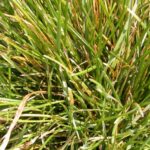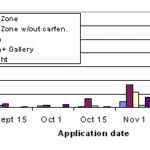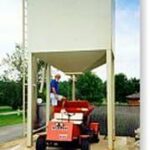Turf Tips Archives
Controlling broadleaf weeds after the drought
Now that the lawn and weeds have greened-up from the recent rains, broadleaf herbicides should be effective yet this fall. Though these herbicides work faster when the plants are actively growing, these herbicides will still work as long as the plants are green and photosynthesizing. Therefore, applications into November will work, albeit slower. You may […]
Upcoming Open Positions on the MRTF Board of Directors
There will be a number of openings on the MRTF Board of Directors in the upcoming December elections. MRTF’s mission is to support research and education and thus help advance our industry. We are looking for potential board members dedicated to our industry and desiring to help steer the direction of turfgrass research and education. […]
A Dry Lawn in October is Reason for Concern
Though areas of Indiana received some rain this week and more is forecasted, most of the state has received precipitation far below normal. Many lawns look as brown now as they normally do in August. This does not bode well for winter survivability of grass and the appearance of the lawn next year. September and […]
Coping with Late Season Drought in Turf
(Adapted from the Midwest Regional Turf Foundation Factsheet, Oct 1, 2004) After an extremely wet summer, turf drought stress has come out of nowhere almost throughout the state after a dry August and September. Though September and October are prime growing months, turf will not recover unless the turf receives ample rain or irrigation soon. […]
Turf and Ornamental Seminar
Mark your calendars for Nov 15-18 for MRTF’s Turf and Ornamental Seminar. Like last year, the course is advanced for lawn care, golf course, sports turf, and sales staff. The lawn care session will be on Monday and Tuesday, Nov 15-16, while the golf, sports, and sales session will be on Nov 17-18. Topics include […]
MRTF Golf Day at Coyote Crossing on Oct. 14
Openings are still available for the MRTF Golf Day on Oct 14 at the Hale Irwin-designed Coyote Crossing Golf Club in West Lafayette. This is the seventh annual event held to promote turfgrass research, raise awareness of the Purdue Turfgrass Science Program, and provide an enjoyable day of golf. It’s an early morning event starting […]
Gray Leaf Spot 2004
We’ve received several reports of gray leaf spot outbreaks throughout the state during the past couple of weeks. It may surprise many, because the summer of 2004 has been one of the mildest (zero days where temperatures reached 90 F in West Lafayette) in recent memory. It did not surprise us, however, because our research […]
What Happens to Fertilizers and Pesticides Applied to Turf?
Now that we are entering the fertilization season for lawns, questions sometimes arise about where products go after application to lawns. Research at Purdue and many other universities has shown that fertilizers (including both nitrogen and phosphorus) and pesticides applied to turf will not move horizontally (runoff) or vertically (leaching). This is because the relatively […]
September Grub Damage
White grub damage on turfgrass may be more widespread than many expected this year. With ample rain and favorable growing conditions for most host plants during the early and mid growing season, high concentrations of adult Japanese beetles were not as common as in previous years. This may have lulled turfgrass managers into forgetting about […]
Rust Revival!
Well it must be September and it must finally be dry because I have seen some serious outbreaks of rust on many perennial ryegrass lawns throughout the area over the past week. Leaf rust has been most noticeable on lawns that are newly planted and malnourished, both excellent conditions favoring the development of this turf […]
Attempting Ground Ivy Control
I’ve received a number of calls recently on ground ivy control. Here’s a rerun on an August Turf Tip on controlling ground ivy. Background Ground ivy is difficult to control and it is a problem in 31% of lawns maintained professionally in Indiana. Earlier research by Eric Kohler has expanded our understanding of ground ivy […]
Late-summer Aerification check-List
Although this past growing season across most of Indiana has been cool and moist this is no reason to consider skipping fall core cultivation or aerification. In fact, this abnormal weather pattern is actually more conducive to thatch accumulation since many of the microbes responsible for organic matter break-down are less active in these conditions. […]
Purdue Turfgrass Research Report Available On-Line
Though members of the Midwest Regional turf Foundations received compact discs of our 2003 Research Summary a number of weeks ago, the same research summary is now available online at http://www.agry.purdue.edu/turf/report/report.htm. The overall goal of our research program is to minimize inputs while maintaining turf quality, minimizing costs, and further protecting our environment. Our research summary […]
Turf 101: Why does September Fertilization of Cool-Season Grasses Work?
Normal growth patterns of cool season grass produce most leaf growth in the spring. Therefore fertilization in spring tends to stimulate even more leaf growth which may in turn decrease long-term stress tolerance in the summer months. On the other hand, cool season grasses tend to slow down leaf growth in the fall producing relatively […]
September is a Crucial Time to Fertilize All Cool-Season Turfs
Early to mid-September is the most important time to fertilize cool-season turfgrasses like creeping bentgrass, Kentucky bluegrass, perennial ryegrass, and tall or fine fescue. September fertilization is crucial on all turf areas regardless if it is a lawn, athletic field, or golf course green, tee or fairway. Fertilization in mid-September encourages the production of new […]
Seed Now!
We’re still in the middle of the optimum seeding window for cool-season turfgrasses. The optimum time to seed cool-season turfgrasses is between Aug. 15 and Sept. 15 in central IN, a week earlier in northern IN, and a week or so later in southern IN. It is important to seed as earlier as you can […]
More Evidence for Effectiveness of Fall Applications of Broadleaves
It’s been fairly well established that fall applications of herbicides are more effective than spring applications for broadleaf control. Recent work in Nebraska reported that applications of 2,4-D and/or dicamba were far more effective in controlling dandelions and Canada thistle when applied 1 to 10 days after the first fall frost than when applied 5 […]
Wait to Control Broadleaf Weeds
Though many broadleaf weeds like ground ivy, clover, and plantain are currently thriving in turf areas, resist the urge to spray them now. Following is a summary of a study that we discussed at Field Day that can help professionals improve broadleaf weed control, especially difficult-to-control weeds like ground ivy. Background Ground ivy is difficult […]
Rust in Turf
The rain and temperatures this year have favored excellent turfgrass growth, and the N applied this spring is being depleted, thus favoring rust in even regularly fertilized turf areas. Rust symptoms are reddish-orange lesions or spots on the leaf blades and a rust-colored powder that you can rub off with your fingers. Rust will rarely […]
Turf Field Day Held July 27
Thanks to everyone who attended and helped make the 2004 Midwest Regional Turf Field Day a success on Tuesday, July 27. A clear day with temperatures in the 70’s was almost perfect for the nearly 700 attendees. Attendees had the opportunity to view the latest in turfgrass research, visit with Purdue specialists, see the most […]



